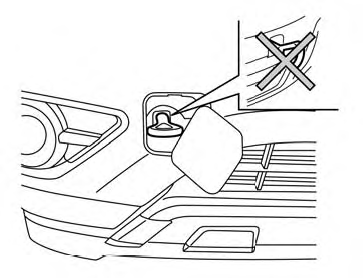Vehicle recovery (freeing a stuck vehicle)

Pulling a stuck vehicle
WARNING
To avoid vehicle damage, serious personal injury or death when recovering a stuck vehicle:
● Contact a professional towing service
to recover the vehicle if you have any
questions regarding the recovery
procedure.
● Attach recovery devices only to main
structural members of the vehicle or the
recovery hooks.
● Do not use the vehicle tie-downs to tow
or free a stuck vehicle.
● Only use devices specifically designed
for vehicle recovery and follow the
manufacturer’s instructions.
● Always pull the recovery device straight
out from the front of the vehicle. Never
pull at an angle.
● Route recovery devices so they do not
touch any part of the vehicle except the
attachment point.
If your vehicle is stuck in sand, snow, mud, etc., use a tow strap or other device designed specifically for vehicle recovery. Always follow the manufacturer’s instructions for the recovery device.
Do not use the tie-down hooks for towing or vehicle recovery.
Rocking a stuck vehicle
WARNING
● Stand clear of a stuck vehicle.
● Do not spin your tires at high speed. This
could cause them to explode and result
in serious injury. Parts of your vehicle
could also overheat and be damaged.
If your vehicle is stuck in sand, snow, mud, etc., use the following procedure:
1. Turn off the Vehicle Dynamic Control System
(VDC).
2. Make sure the area in front and behind the
vehicle is clear of obstructions.
3. Turn the steering wheel right and left to clear
an area around the front tires.
4. Slowly rock the vehicle forward and backward.
● Shift back and forth between R (Reverse)
and D (Drive).
● Apply the accelerator as little as possible
to maintain the rocking motion.
● Release the accelerator pedal before
shifting between R and D.
● Do not spin the tires above 35 MPH
(55 km/h).
5. If the vehicle cannot be freed after a few tries, contact a professional towing service to remove the vehicle.
See also:
Around viewTM monitor (if equipped)
The CAMERA button is located on the center console.
When you push the CAMERA button or shift the selector lever into the “R” (Reverse)
position while the ignition switch is in the ON position ...
How to adjust the screen
To adjust the Display ON/OFF, Brightness, Tint,
Color, Contrast and Black Level of the RearView
Monitor, press the SETTING button with the
RearView Monitor on and select the “Display”
key. Sel ...
Environmental factors influence the rate of corrosion
Moisture
Accumulation of sand, dirt and water on the
vehicle body underside can accelerate corrosion.
Wet floor coverings will not dry completely
inside the vehicle, and should be removed for
d ...
